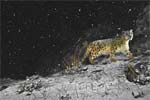Wildlife Photographer of the Year 2009
 The Wildlife Photographer of the Year 2009 competition is now open for entries. The Veolia Environnement Wildlife Photographer of the Year 2009 contest has 17 categories (14 for adults and three for children). Prize money is £10,000 for the overall winner and up to £1,000 for the category winners. Last year’s overall winner was American photographer Steve Winter for his image Snowstorm leopard (pictured). The closing date is 27th March 2009.
The Wildlife Photographer of the Year 2009 competition is now open for entries. The Veolia Environnement Wildlife Photographer of the Year 2009 contest has 17 categories (14 for adults and three for children). Prize money is £10,000 for the overall winner and up to £1,000 for the category winners. Last year’s overall winner was American photographer Steve Winter for his image Snowstorm leopard (pictured). The closing date is 27th March 2009.
Wildlife Photographer of the Year Press Release
Call for the wild: Entries for Veolia Environnement Wildlife Photographer of the Year 2009 open
The Wildlife Photographer of the Year competition today begins its annual global search for the best and most creative visions of nature, whether they come from the wildest places on Earth or urban gardens.
Entries for the world’s most prestigious wildlife photography competition open on 19 January and close on 27 March (20 March for postal entries). The 2008 contest attracted a record 32,351 entries from 82 countries.
This year the competition is being sponsored by Veolia Environnement, a world leader in environmental services, and will be known as ‘Veolia Environnement Wildlife Photographer of the Year 2009’.
CEO of Veolia Environmental Services (UK) Plc Jean-Dominique Mallet said ‘Veolia Environnement works with businesses, communities and governments to minimise our daily impact on the environment. It is therefore our privilege to sponsor a competition that features the world’s best wildlife photography and puts into clear focus the beauty and richness of nature which we all have a communal responsibility to protect.’
The 2008 winning images are currently on exhibition at London’s Natural History Museum as well as touring internationally to a total of 60 cities. The photos are also published in a hardback book and in a special supplement of BBC Wildlife Magazine. The competition, owned by the Museum and the Magazine, has been running annually since 1964.
Chair of the judging panel, zoologist, writer and photographer, Mark Carwardine said ‘Each year this great showcase for photographers raises the bar for innovative nature photography and plays an increasingly crucial role in provoking awareness of wildlife conservation’.
Mark said ‘Millions of people see the winning photographs through the exhibition and the media coverage it generates. They not only get enjoyment from the visual impact of these images, they also gain new insights into the natural world.
‘The most important element for a winning photograph is originality. The judges will be seeing thousands of technically perfect, well-composed images. The ones that leap from the screen are those where the photographers have worked creatively to capture a different way of showing the drama, beauty or unique behaviour of the subject.’
Last year’s overall winner was American photographer Steve Winter for his image Snowstorm leopard. Mark said ‘Everything comes together in this striking picture – the drama of the snow, the mystery of the darkness, the posture of the rarely photographed snow leopard and the intriguing composition’.
Other successful photographs from the 2008 competition included Brian Skerry’s Underworld shot of a blue cod strolling on its fins through an otherworldly garden of vibrant soft corals and starfish. The soft corals are sea pens – usually found at considerable depths. But they grow in the shallow waters of Long Sound Marine Reserve in New Zealand, where tannin-stained surface water blocks out sunlight, ‘tricking’ deep-water animals into settling at shallower depths.
Macro-photographer Danny Laps was highly commended for Saffrondrop bonnets. He found these diminutive mushrooms in a dark Belgian wood, and was charmed by their delicate, glowing colours, softened by the light streaming through the beech leaves.
The judges were taken by how David Hall’s Soft-coral community resembled a Japanese print for colour and delicacy, and how the simplicity of Miguel Lasa’s Polar sunrise – a polar bear backlit by the first rays of sunlight – provided a fresh look at a well-photographed subject.
Mark explained ‘It’s not what you photograph – it’s the way you do it. Pictures of common or familiar species, close to home, stand just as much chance of winning as pictures of more exotic or rare ones. I’d particularly like to urge professional and keen amateur photographers to consider the Urban and Garden Wildlife category. It’s often overlooked, but our gardens and parks provide most of us with our best access to photographing wild animals and plants.’
Veolia Environnement Wildlife Photographer of the Year 2009 has 17 categories (14 for adults and three for children). The adult categories range from animal behaviour and plants to urban wildlife and underwater photography. There are also special awards for images of endangered wildlife and portfolios taken by photographers aged 18–26.
Photographers can enter online at www.nhm.ac.uk/wildphoto or by posting a CD of images to the competition office. All images must be in digital format – scans of transparencies, or originally captured digital images. Up to three images can be entered in each category for a flat fee of £20 (£27 if entering by post). Prize money is £10,000 for the overall winner and up to £1,000 for the category winners.
Entry is free for the three youth categories, 10 years and under, 11–14 years and 15–17 years.
The overall winner of the Veolia Environnement Young Wildlife Photographer of the Year title receives £500 and a day’s workshop with a professional wildlife photographer. Category winners receive £250.
Photo Credit - Snowstorm leopard - Steve Winter / Wildlife Photographer of the Year
Veolia Environnement Wildlife Photographer of the Year is owned by the Natural History Museum and BBC Wildlife Magazine

Loading comments…